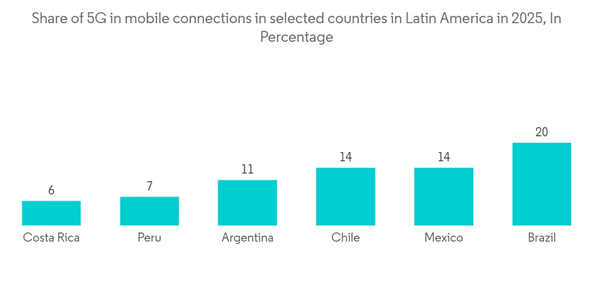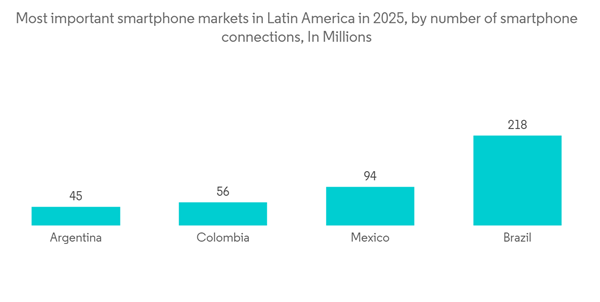The Latin American IT device market is expected to grow at a CAGR of 1.1% over the next five years. The higher demand for notebooks and personal computers during the time of the COVID-19 pandemic and the rising need to stay connected to people led to the demand for mobile phones across the region.
This product will be delivered within 2 business days.
Key Highlights
- The rapid implementation of the internet of things (IoT) across the region extends internet access to various devices that employ embedded technology to communicate and interact via the internet. This is increasing the demand for both innovation and more conventional and IoT-enabled devices like desktop and laptop computers, cell phones, and tablets.
- Smartphones have evolved into essential tools for people worldwide, and Latin America is no different, whether they are used for communication, information access, or entertainment. The booming e-commerce business in Latin America has a natural effect on the rise in smartphone use. Brazil, Mexico, and Argentina have the most potential online sales marketplaces, and the COVID-19 pandemic helped popularise online purchasing in these countries.
- However, Latin America is experiencing the highest rate of inflation growth in more than the last two decades. In Q1 this year, OEMs in Latin American markets were engaged in an intense price war, which lessened the effects of consumer demand that had begun to decline. However, this situation may die down in the future, particularly for smartphones in the mid-to-high price band segment.
- Furthermore, the launch of expensive smartphones in the market, coupled with the roll-out of 5G in the region, has pent up a sizeable market for mobile phones in countries like Brazil and Argentina. Notably, the spread of high-end smartphones in the market and the low purchasing power of Brazilians have contributed to the demand for refurbished second-hand smartphones in the country.
- The COVID-19 pandemic propelled computer/laptop and tablet sales across the region. The Brazilian computer market has witnessed a trend shift, and it is experiencing higher demand from enterprises of all sizes and the government sector. The post-COVID demand for official computers has been robust in this region on the back of replacement orders of old, outdated systems that couldn’t take place for the last two years. Also, the e-commerce market in Peru, Mexico, Argentina, and Colombia increased almost ten times during the COVID-19 pandemic, thereby driving escalated demand for smartphones in the area.
Latin America IT Device Market Trends
Upsurge in Smartphone Adoption in the Region
- With over 20% of the market share in Peru, Chile, Colombia, and Mexico at the end of 2020, Huawei is one of the most popular smartphone brands in Latin America among Chinese smartphone manufacturers. However, Xiaomi smartphones became more popular in the previous year. Xiaomi is a brand known for its affordability. It has been on the Latin American market for a few years, overtaking Apple's market share in the region, and is now the third most popular brand, behind Samsung and Motorola.
- The number of smartphone subscribers in Latin America is expected to rise by around 100 million in seven years, with Brazil maintaining the region's most significant smartphone market. It is estimated that there will be more than 200 million smartphone connections in the nation by 2025. As per GSMA, the smartphone adoption rate in Brazil is expected to rise from 86% (the region's highest) to 88% in 2025. Notably, Latin America's smartphone adoption rate is expected to grow from 76% in the last year to 83% in 2025.
- The booming e-commerce business in Latin America has an impact on the rising smartphone use. Brazil, Mexico, and Argentina have the most potential internet sales marketplaces, and the COVID-19 pandemic helped popularise online purchasing. Retail e-commerce using mobile devices was expected to reach USD 26.8 billion this year, up from USD 18.32 billion in 2019.
- According to GSMA, Brazil is predicted to have the biggest percentage of 5G mobile connections in Latin America by 2025, making up 20% of all mobile connections in the nation. With each having a 14% stake, Mexico and Chile are next.
Brazil is the Major Contributor to the Market
- Despite the challenges the pandemic brought to the sector, the Brazilian personal computer market remained robust last year, with a large growth in sales. According to the research, the market grew in the first three months of the previous year, and the trend persisted in the second and third quarters of the year. In comparison to 2020, the Brazilian PC market saw a growth of 37% last year.
- As the market leader, Dell displayed a strong performance in PC sales in Brazil in the final three months of the previous year. The business accounted for 22.6% of sales in the national computer market in the fourth quarter of the last year, focusing on the small business segment, which had a 38.9% increase in sales over 2020 and captured a 51.8% market share. Other leading PC brands in Brazil include Samsung, Acer, Lenovo, Positivo, and Apple (Macbook).
- Furthermore, Brazil is the fifth-highest smartphone user country in the world. The Brazilian population is an avid smartphone user and has the highest smartphone adoption rate across the region. As per the reports, the country's smartphone adoption rate of the country is expected to increase from 86% in the last year to 88% in 2025.
- Rapid internet coverage in Brazil is a major contributor to the demand for smartphones in the country. Although 5G coverage has been limited to major cities of the Latin American region, Brazil, with 5G coverage in more than 22 odd cities, is among the most covered areas. Right now, Brazil, along with Peru, is leading the 5G rollout of the region.
- Noticeably, Brazil has witnessed a steady rise in e-commerce over the past few years. The expansion in cross-border commerce has been fuelled by the volume of orders, which rose 15% in 2021 compared to 2020. The nation has become more mobile-focused with the increase of e-commerce and online cross-border business across the country.
- According to GSMA projections, Brazil will have 218 million smartphone connections, making it the largest smartphone market in Latin America by the end of 2025, followed by Mexico with 94 million and Columbia with 56 smartphone connections.
Latin America IT Device Market Competitor Analysis
The Latin American IT device market is fragmented as it consists of several key players. They are in constant efforts to bring advancements. A few prominent companies are entering into collaborations and expanding their global footprints in developing regions to consolidate their positions in the market. The major player in this market includes Samsung, Motorola, Apple, Lenovo, and HP.- In October 2022, Microsoft declared the launch of surface laptop 5, Pro 9, and Studio 2. At the launch, Microsoft also unveiled many intriguing new features for Windows 11. The IT giant has continuously pushed the boundaries of traditional computing with the vision and pursuit of innovation.
- In September 2022, Nokia announced that it had partnered with Flex Brazil, the multinational electronics company, to set up 5G standalone private wireless networks throughout all its Brazilian production locations. Through a strong 5G network, the firms seek to jointly provide cutting-edge manufacturing solutions to Brazil's growing Industry 4.0 industry.
Additional benefits of purchasing the report:
- The market estimate (ME) sheet in Excel format
- 3 months of analyst support
This product will be delivered within 2 business days.
Table of Contents
1 INTRODUCTION
4 MARKET INSIGHTS
5 MARKET DYNAMICS
6 MARKET SEGMENTATION
7 COMPETITIVE LANDSCAPE
Companies Mentioned (Partial List)
A selection of companies mentioned in this report includes, but is not limited to:
- HP Inc.
- Dell Technologies
- Acer Group
- Lenovo Group Limited
- ASUSTek Computer Inc
- Apple Inc
- Microsoft Corporation
- Honor Technology, Inc.
- Samsung Electronics Co., Ltd.
- Motorola, Inc.
- Xiaomi Corporation
- Huawei Technologies Co., Ltd.
- Guangdong Oppo Mobile Telecommunications Corp., Ltd
- Vivo Communication Technology Co. Ltd.
- Nokia Corporation
- Zhongxing New Telecommunications Equipment Co., Ltd
Methodology

LOADING...










